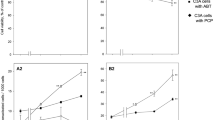Abstract
The transformation of a rat liver epithelial cell line under a wide range of doses of chromium was determined by anchorage-independent growth and tumor formation in syngeneic animals. Chronic exposure to low concentrations and brief exposure to high concentrations of hexavalent chromium (K2CrO4) transformed the cells, but one dose (1 mM K2CrO4, 2h) was clearly optimal in this regard. The cytotoxicity, effects on cell cycle, rates of chromium uptake, and mutagenic activity under the different treatment conditions were evaluated. The results showed that cells could adapt to the presence of chromium under certain treatment conditions, but this was not the case for the optimal transforming dose. Cells treated with chromium above the optimal transforming dose showed evidence of a transient G2 arrest, whereas all lower levels of treatment did not. A low level continuous exposure to chromate was mutagenic, whereas high level short exposures, including the optimal transforming dose, were not. An increase in the amount of protein complexed with isolated nucleic acids was detected in cells following treatment with the optimal transforming dose of chromate. The results indicate that the effects of chromium on this in vitro system vary with dose; and the identification of those events relevant to metal carcinogenesis will require consideration of treatment conditions.
Similar content being viewed by others
References
F. W. Sunderman, Jr.,Biol. Trace Element Res. 34, 63 (1979).
F. W. Sunderman, Jr.,Ann. Clin. Lab. Sci. 14, 93 (1984).
A. Fornace, D. Seres, J. Lechner, and C. Harris,Chem.-Biol. Interact. 36, 345 (1981).
M. Tsapakos, T. Hampton, and K. Wetterhahn,J. Biol. Chem. 256, 3623 (1981).
M. Tsapakos, T. Hampton, and K. Wetterhahn,Cancer Res. 43, 5662 (1983).
M. Sugiyama, X. W. Wang, and M. Costa,Cancer Res. 46, 4547 (1986).
A. Wedrychowski, W. Ward, W. Schmidt, and L. Hnilica,J. Biol. Chem. 260, 7150 (1985).
Z. Banjar, L. Hnilica, R. Briggs, J. Stein, and G. Stein,Biochem. Biophys. Res. Commun. 114, 767 (1983).
R. San, T. Shimada, C. Maslansky, D. Kreiser, M. Laspia, J. Rice, and G. Williams,Cancer Res. 39, 4441 (1979).
J. A. Briggs and R. C. Briggs,Cancer Res. 48, 6484 (1988).
R. S. Gupta and B. Singh,Mutat. Res. 94, 449 (1982).
O. Bakke, K. Jakobsen, and K. Eik-Nes,Cytometry 5, 482 (1984).
Author information
Authors and Affiliations
Rights and permissions
About this article
Cite this article
Briggs, J.A., Briggs, R.C. The in vitro transformation of a rat liver epithelial cell line with chromium. Biol Trace Elem Res 21, 431–435 (1989). https://doi.org/10.1007/BF02917285
Received:
Accepted:
Issue Date:
DOI: https://doi.org/10.1007/BF02917285




